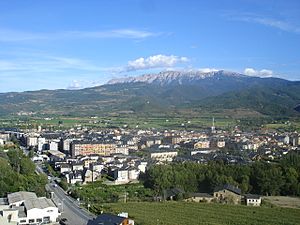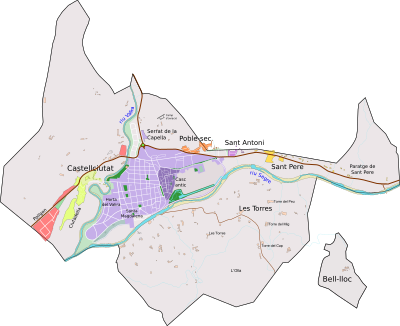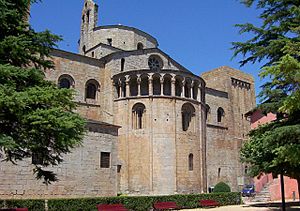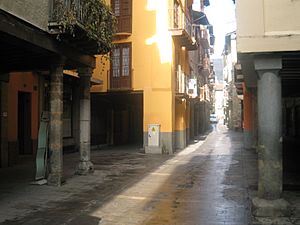La Seu d'Urgell facts for kids
Quick facts for kids
La Seu d'Urgell
|
||
|---|---|---|
|
Municipality
|
||

Seu d'Urgell Cathedral
|
||
|
||
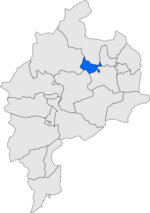
Location in Alt Urgell county
|
||
| Sovereign state | ||
| Community | ||
| Region | Alt Pirineu | |
| County | Alt Urgell | |
| Province | Lleida | |
| Area | ||
| • Total | 15.4 km2 (5.9 sq mi) | |
| Elevation | 691 m (2,267 ft) | |
| Population
(2018)
|
||
| • Total | 12,041 | |
| • Density | 781.9/km2 (2,025/sq mi) | |
| Demonyms | Urgellenc, urgellenca or Urgellès, urgellesa |
|
| Climate | Cfb | |
La Seu d'Urgell is a town in Catalonia, Spain. It's located in the Alt Urgell county, which is part of the Alt Pirineu region. This town is very important because it's the home of the Bishop of Urgell. The Bishop is one of the two co-princes of Andorra, a small country nearby.
La Seu d'Urgell is the biggest town in its region. It sits where two rivers meet: the Segre and the Valira. The area around the town is called Urgellet. This region is in the Pyrenees mountains. Long ago, Urgellet and Andorra were part of the original County of Urgell. La Seu d'Urgell was its capital.
The town is a main entry point to Andorra. Being close to Andorra, a busy economic center, helps La Seu d'Urgell stay lively and important in the Alt Pirineu region.
The town has special patron saints. These include Saint Ot of Urgell, Saint Sebastian, and the Virgin of Urgell. Sant Ermengol is also very important here. Many events throughout the year are dedicated to him. For example, the Sant Ermengol Fair is one of the oldest fairs in Catalonia.
The Segre Olympic Park is a cool place in La Seu d'Urgell. It was built for the 1992 Summer Olympics in Barcelona. It's a special course for canoe and kayak sports.
Contents
What's in the Name?
The name La Seu d'Urgell comes from two old words. Seu means "seat" in Latin. It refers to the seat of the Bishop. Urgell is an even older name. It might be linked to water, as a linguist named Joan Coromines suggested.
Long ago, there was a settlement called Arse-durgui on a hill. This hill was known as Puiolo Urgelli. Later, a city called Urgell was built there. This is where the name Castellciutat comes from. Until the 1700s, the town was just called "Ciutat" (which means City). "Castell" (Castle) was added later. This was because an old castle, home to the Counts of Urgell, was there.
After the old city was destroyed, a new area grew. This became the new home for the Diocese of Urgell. It was called vicus Sedes Urgelli. This name showed it was the Bishop's main town. Over time, Sedes Urgelli became more important. It dropped the word vicus. The old city, civitas Orgellia, became just Civitas.
Where is La Seu d'Urgell?

The city is in a flat area, about 7 kilometers long. It's 691 meters high. High mountains, like the Cadí mountain range, surround it. The Segre river created this flat area, which is called plana de la Seu.
La Seu d'Urgell is at a key meeting point for roads in the Catalan Pyrenees. Roads leading to Andorra, Cerdanya, and the lower Segre all come together here. This has given the town a special role in the county of Urgell throughout history.
Near the Gran Valira river, there's a mountain range. You can find the remains of two big fortresses there. These are the Ciutadella and Ciutat Castle in Castellciutat. Both are important to the town's history.
La Seu d'Urgell shares borders with several other towns. To the north, it borders les Valls de Valira. To the west, it's next to Montferrer i Castellbò, where La Seu d'Urgell Airport is located. To the southwest, it borders Ribera d'Urgellet. To the southeast, it's Alàs i Cerc, and to the northeast, Estamariu. The municipality also includes a small area of land separate from the main part, to the east.
Parts of La Seu d'Urgell
The municipality of La Seu d'Urgell includes several areas:
- Bell-lloc.
- Castellciutat (a small village).
- Les Torres.
- And the main town of La Seu d'Urgell itself, which has different neighborhoods:
- Sant Antoni.
- Sant Pere.
- Poble-sec.
- Other areas like Santa Magdalena, Serrat de la Capella, Eixample Bergós, and the Casc antic (old town center).
Fun Fairs and Festivals
Even though the Alt Pirineu i Aran region doesn't have many people, it hosts lots of events. La Seu d'Urgell has many fairs and markets all year long:
- A traditional market happens every Tuesday and Saturday. You can find it on the Main Street.
- The Fira de Sant Ermengol is very old. It's held on the third weekend of October.
- The Fira de Formatges Artesans del Pirineu is a cheese fair.
- A Spring Fair takes place in April. It shows off the best Vaca bruna dels Pirineus, a special cow from the Pyrenees.
- Fira d'Art is an art show that started in 2007.
- Mercat Medieval dels Canonges is a medieval festival. It has street music, theater, circus acts, and old crafts.
- Mercat de les Opportunitats is a market held twice a year.
- The International Music Festival Joan Brudieu started in 1969. It takes place in July and August.
Cool Places to See
- Churches and old buildings:
- The Cathedral of La Seu d'Urgell is in Oms square.
- You can visit the Cloisters of the cathedral.
- The Diocese of Urgell Museum has old treasures, like the Urgell Beatus manuscript.
- The Palau Episcopal de la Seu d'Urgell (Episcopal Palace) has a beautiful courtyard.
- The Library of Sant Agustí is now the town's library. It used to be an old convent.
- The Church of Sant Miquel is very old. It's the only building left from the cathedral complex built around the year 1035.
- The Old Church of Santa Immaculada will become a conference room.
- The Old Church of Sant Domènec is a Gothic building. It's used for talks and art shows.
- The Church of Santa Magdalena is a very important church for the community.
- The Seminari conciliar is a large building with a grand front. It was built in 1860.
- Old Town: This historic center has charming streets like Canonges street and Main Street. They have beautiful old buildings. The Palau courtyard and Oms square are also here. The Passeig de Joan Brudieu is a main street that divides the old town from the newer parts.
- Castellciutat village: From here, you get amazing views of the Tower of Solsona, the castle, and Ciutadella.
- Learning Centers:
- The Cultural Center "Les Monges" has schools for dance, music, and art. It also has a childcare center.
- IES Joan Brudieu is a high school for teenagers.
- Nature: The Cadí-Moixeró Natural Park is a great place to explore nature nearby.
Sports Fun
The town has a special artificial whitewater course called Parc Olímpic del Segre. This is where the canoe slalom events were held for the 1992 Summer Olympics! La Seu d'Urgell has also hosted the ICF Canoe Slalom World Championships multiple times, in 1999, 2009, and 2019.
How Many People Live Here?
The number of people living in La Seu d'Urgell has grown over the years:
| 1900 | 1930 | 1950 | 1970 | 1986 | 2019 |
|---|---|---|---|---|---|
| 3520 | 4584 | 7062 | 9404 | n/a | 12089 |
The numbers include the areas of les Torres (added in 1857) and Castellciutat (added in 1975).
Tallest Mountains Nearby
Here are some of the highest peaks close to La Seu d'Urgell:
- Pic de Salòria is 2,789 meters high.
- Monturull is 2,761 meters high.
- Torreta de Cadí is 2,562 meters high.
- Cap del Verd is 2,282 meters high.
- El Coscollet is 1,610 meters high.
Famous People
The writer Teresa Colom i Pich was born in La Seu d'Urgell in 1973.
See also
 In Spanish: Seo de Urgel para niños
In Spanish: Seo de Urgel para niños





